How To Design A Reach In Wardrobe
ClosetMaid is so versatile, you can use it in almost any room in the home. However wardrobes / closet systems are still the most popular uses by far.
At ClosetMaid, we offer a fantastic range of packages that you can choose from. Select the size nearest to your available space and trim any excess so that the shelving suits your measurements exactly! We also offer a free design service, so you can let us design your perfect closet. However, reach in wardrobes are very easy to design yourself and you can order each shelf and bracket etc. separately to achieve the ultimate organised wardrobe!
Here, we have given you a step by step guide to show just how easy it is to design your own closet system using the ClosetMaid Shelf & Rod range. At the end, we've even included a shopping list, so if you like our design you can purchase it for yourself, or just use it as a guide to help you understand the quantities of hardware etc. you may need for your own design.
This tutorial illustrates how to design a reach in wardrobe system. Reach in wardrobes are those classified as a single wall/ enclosure that you literally 'reach in' to instead of walk in to. Reach in wardrobes will require mounting to a main wall (rear wall) as well as any side / end walls that may be available. However if you don't have one or either side / end wall, it's not a problem. We have hardware to create an 'open end' / floating shelf design where all fixings go onto the back wall. You will find a separate blog on how to create an open ended closet system in our design guides section.
We hope this tutorial will go some way in showing you just how simple it is to create and install your own custom closet system. But if you have any questions, feel free to contact us on 01622 870050.
Step one - Measure your space
Run a tape measure across the back wall from side to side to determine the width of the space you'd like to use. Bear in mind that if you have any obstacles or a door etc. that opens onto this space, your design needs to allow enough room for this.
Also make a note of the internal depth of your space (measurement of side / end walls). This will be important to determine what will reasonably fit in your space, particularly if you have or plan to put doors across the front of your wardrobe. Generally we say that a reach in closet should be at least 50cm (20") and ideally 61cm (24") deep.
Make sure that you also measure the height of your closet. This too will be important to help you maximise your storage potential. If you plan to include two tier hanging space, you will need a minimum ceiling height of 216cm (85").
For the purpose of this tutorial, our reach in closet is 200cm / 78.7" Wide x 244cm / 96" High x 61cm / 24" Deep.
Some people have sloping ceilings to contend with, and if you're one of them, note that it's not recommended to fit shelving to the sloping ceiling, but instead work around it and maximise the rest of the storage space where you have a perpendicular wall to fix to. If you need help, contact us for a custom design here.
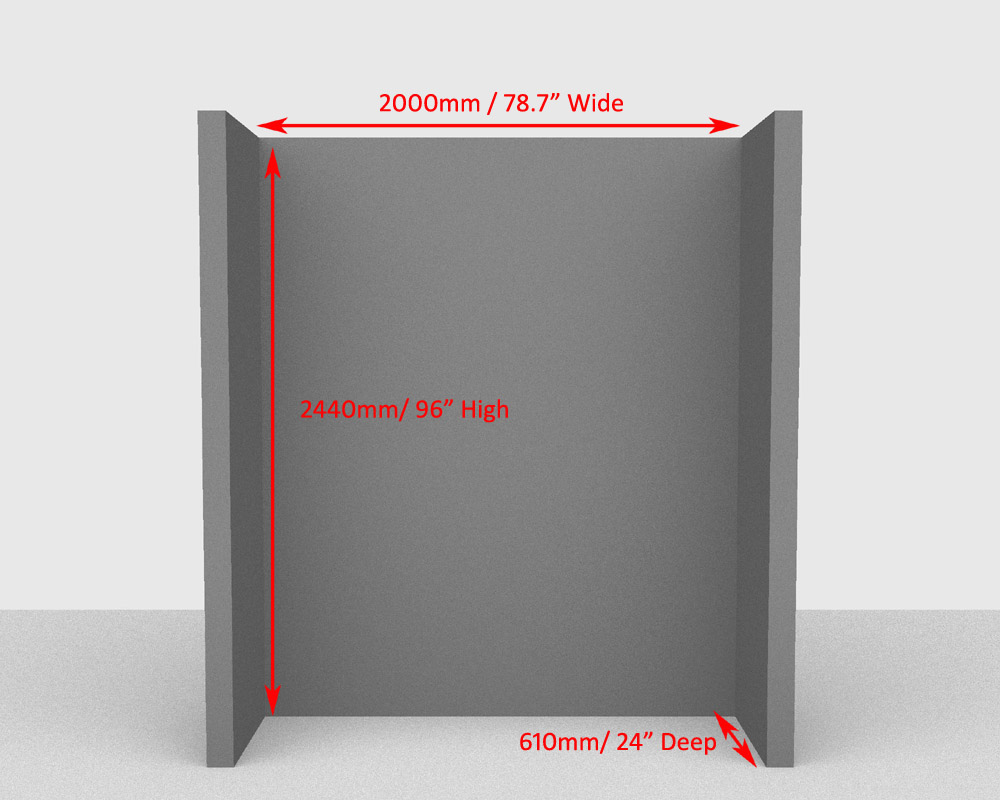
Step two - Decide what you want to store
ClosetMaid Organiser Kits are great and offer you a budget friendly, simple way to get organised. However we recognise that people have different storage needs, which is why you may prefer to design your wardrobe.
It sounds obvious but it's important that you consider what it is that you actually need to store in your reach in wardrobe, so that you ensure enough space for everything and won't find yourself still cramming things into a useless closet. Now is also a great time to have a declutter, so that you remove any items that you no longer wear/ need and only make space for those items you truly require on a regular basis.
Take a look at what clothes you have and the space you already use to store your clothes. Measure how much room your short hanging items take up. If you need to allow extra room for short garments, factor this in.
Do you need hanging for coats / dresses etc?
Do you have any garments which are longer than your blouses/ shirts etc. but not exactly 'long hanging garments'? Items such as long skirts, short dresses, tuxedos, overcoats etc.
Do you fold items? Lots of people don't, but perhaps you want to store bed linen or extra towels here? If so, make sure you include some shelving space.
Shoes! This is a big thing for a lot of our customers and shoes can take up a lot of space and get messy if you don't have a proper storage area. You can create angled shoe racks using our ClosetMaid shelving, but simply turned upside down so that the front lip of the shelf acts as a shoe fence preventing them from slipping off and keeping them visible. Some people prefer keeping shoes in boxes, in that case you may just need regular flat shelves.
Step three - Design your ideal closet!
Now that you know what you need to make room for, you can begin to design your closet.
If you have enough height; start by including a full width top shelf. This will provide a great surface for flat and folded items, maximising the storage potential of your full wardrobe space.
If you can, why not upgrade to our 40.6cm/ 16" deep shelving? This will provide extra surface area for storage, but importantly the position of the hang bar remains at 30.5cm/ 12" from the back wall (just like when using our standard 30.5cm/ 12" deep shelving), so you don't lose any depth by opting for the deeper shelf.
For the purpose of this tutorial, we have used our 40.6cm deep Shelf & Rod shelving.
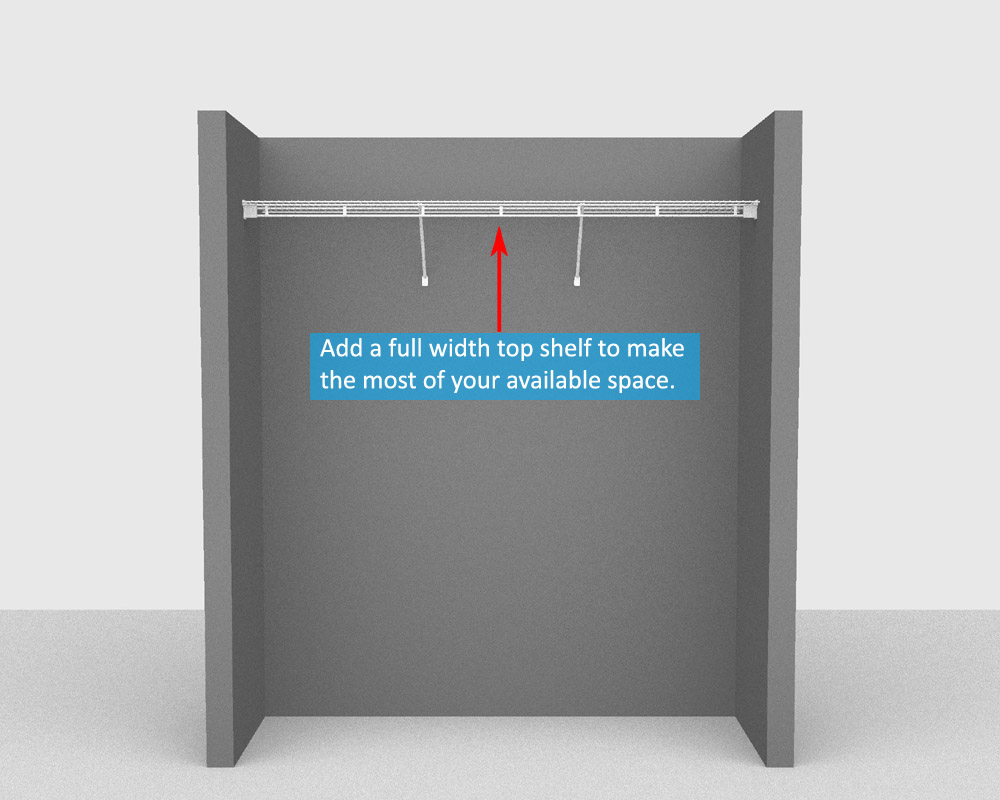
Next add some hanging space.
Short garments: Remember the measurement you had for your current short hanging storage space? Divide this by two and make this the width of your two tier hanging space. Doubling up hanging for short garments is a really effective space saving tip. You use less width of your overall wardrobe space, and by maximising your vertical space, you still have plenty of room for your short garments.
Long hanging garments: Not everyone has long garments, but a little bit of space is handy for dresses/ full length winter coats. Remember if you don't end up using the full length of hanging area, you can make use of the floor space below! Typically we'd suggest a long hanging section be placed at 178cm/ 70" from the floor. Try to keep each section at least 30.5cm/ 12" wide. Anything less than this becomes a bit fiddly to install!
Three Quarter Length hanging garments: Suits, jeans hung at the waist, long skirts... These could be placed in a 3/4 length hanging area, and by adding a separate section in your closet, you can organise your items better making them easier to find, but you can also add extra shelf space above for flat and folded items. Again making use of the vertical space you have.
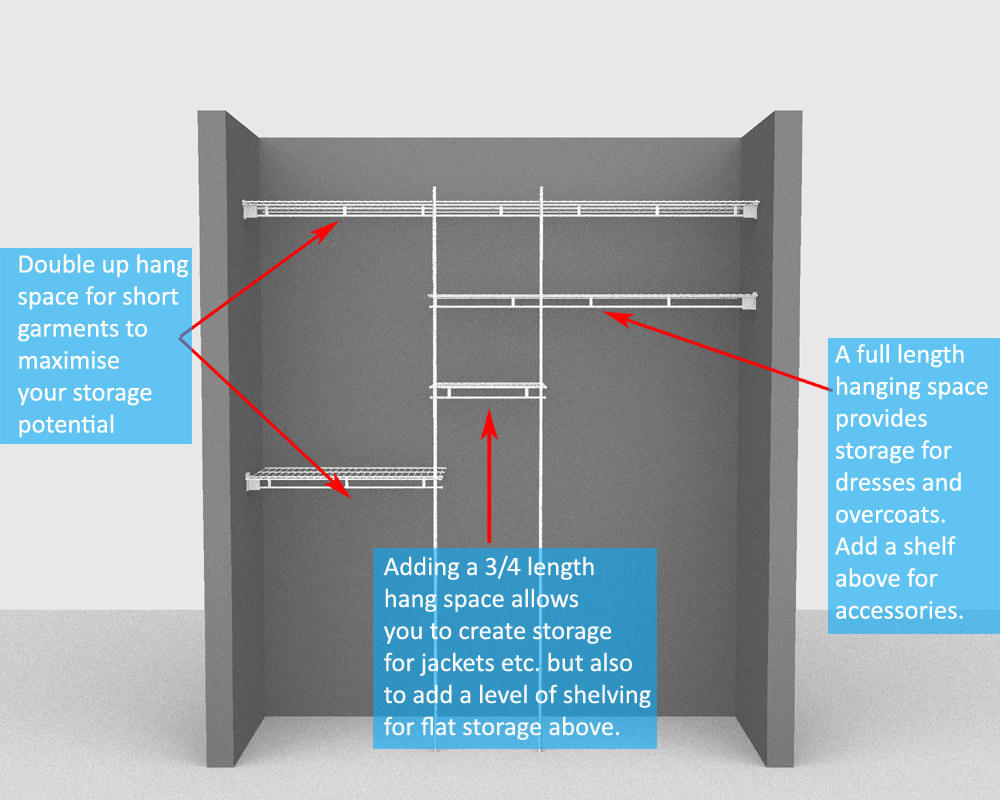
There's no real rule of thumb when considering how much shelving to include. Some people like shelves, whilst others will hang everything or require drawers! The main thing we would recommend though is to ensure you're always considering your vertical space. It's often overlooked, and as earlier mentioned it can be really easy to add shelving above varying levels of hanging space to make the most of your storage. Adding a small shelf stack is always useful for accessories/ shoes/ folded garments and general stuff!
Here we've added a 40.6cm wide shelf stack and split the stack so that you have some flat shelves and some angled shoe shelves. When working out how many shoe racks you need, do a simple calculation based on these measurements;
A typical pair of women's shoes are 20cm (8") wide, a typical pair of men's shoes are 25.4cm (10") wide. Shoe racks should be at least 25.4cm (10") apart when stacking two or more, you may want to allow extra space between shelves for tall boots / stilettos. Why not add shelf liner to stop high heeled shoes slipping through the gaps in our ventilated wire shelves?
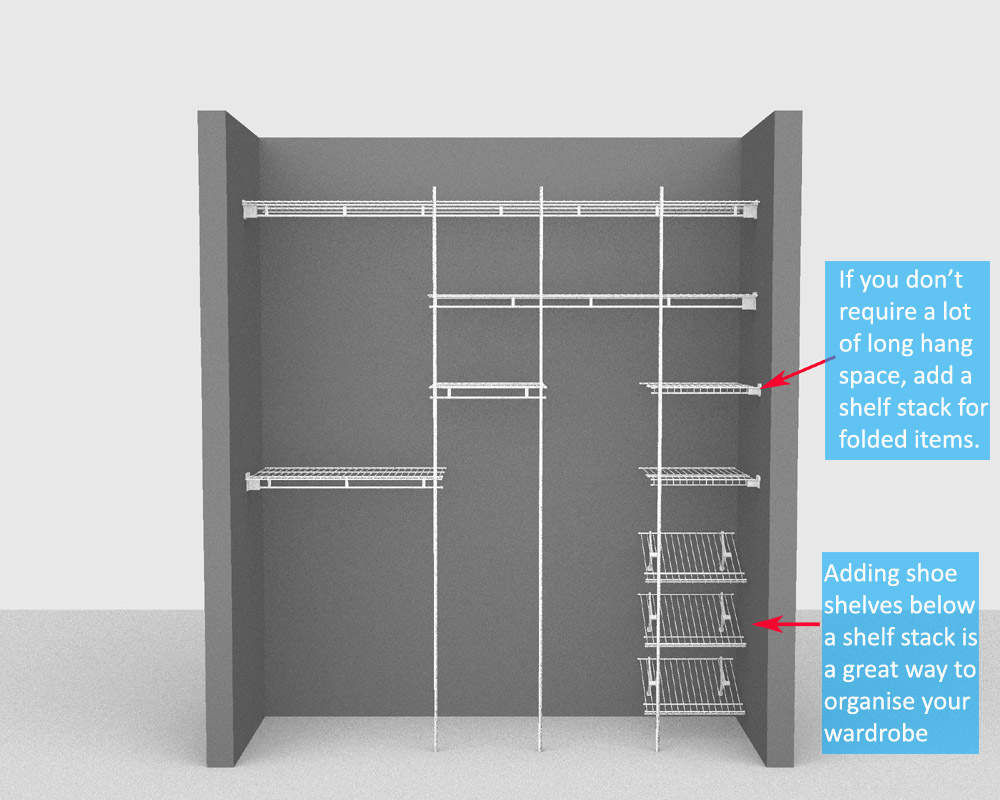
Finally; make sure your closet is well supported. In our enclosure we have side walls to fix to, so make sure you have all the brackets you need. It's often neater to use freestanding shelf support poles when supporting three or more shelves that intersect. Shelf support poles intrude less on the storage space of the shelf below than angled shelf support brackets, so we recommend them when supporting shelf stacks.
When designing a wardrobe using 40.6cm/ 16" deep shelving, it's always worthwhile adding support brackets to the hanging sections. As the hang position sits toward the middle of the shelf, and most fixings support the front edge of the shelf, customers can sometimes experience bowing/ sagging when storing a lot of hanging garments. Therefore, some extra shelf support brackets, which sit at the position of the hang bar, reinforce the shelf and the hang bar when in use.
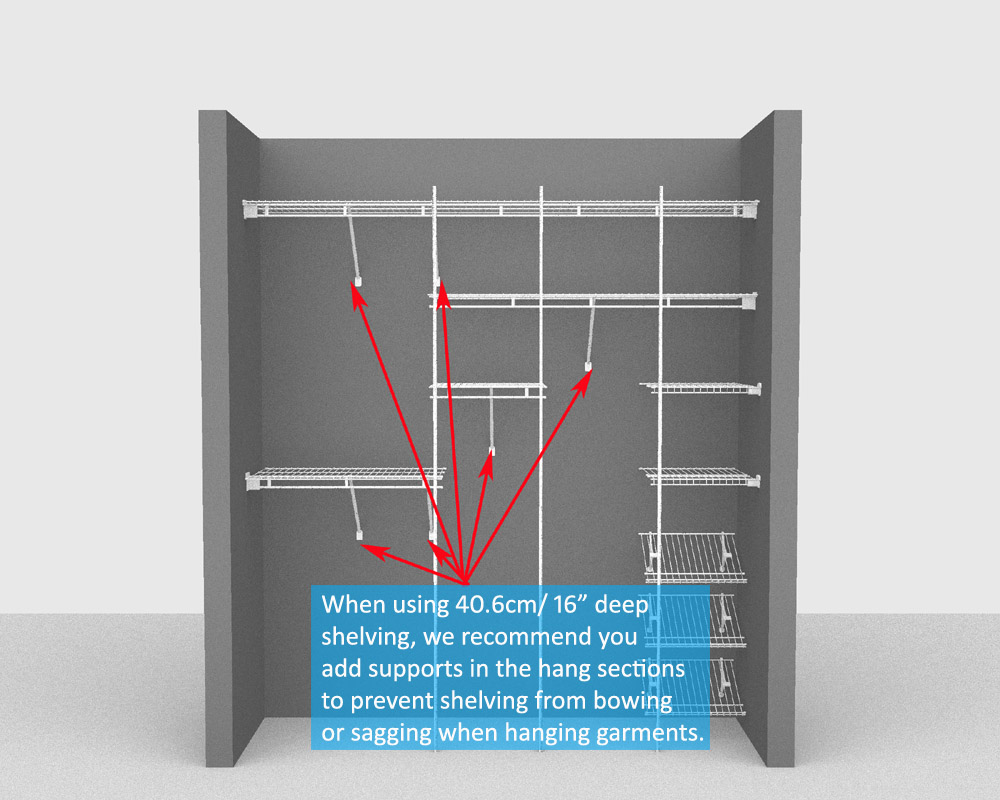
Step four - Your closet: shopping list
And there you have it! Your wardrobe, designed your way.
This design provides up to:
-
1.5m/ 60" of Short hanging space
-
45cm/ 18" of Three quarter length hanging space
-
40cm/ 16" of Long hanging space
-
4.5m/ 178" of Shelving space
-
1.2m/ 48" of Shoe Storage space
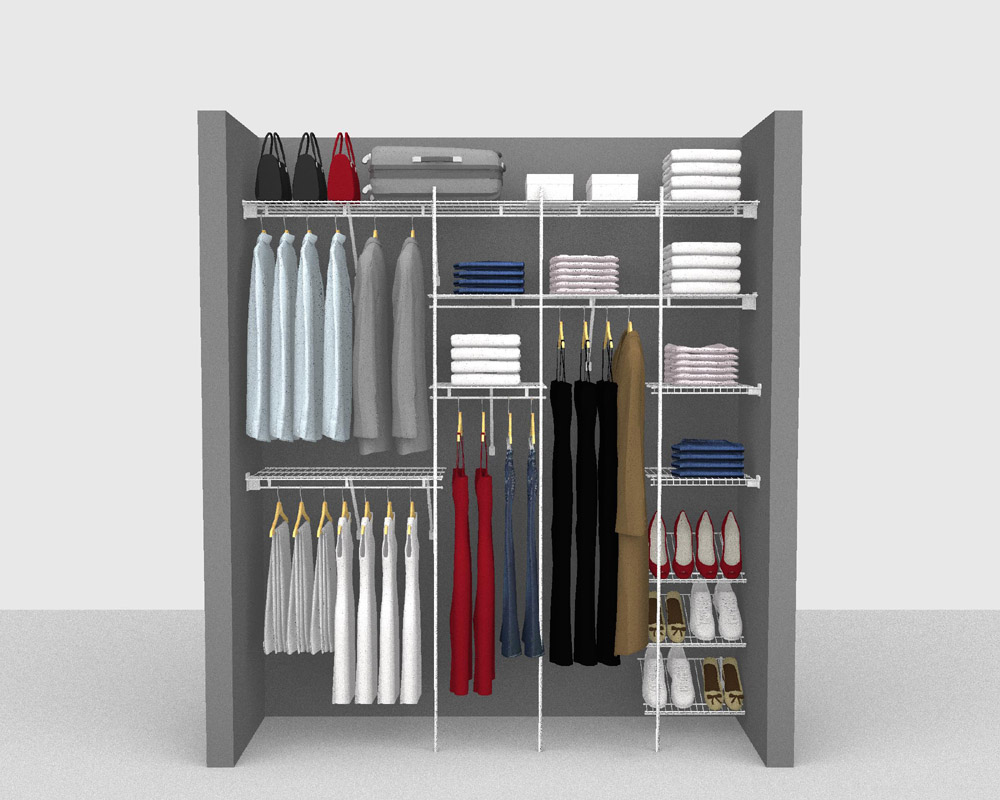
| Part Number | Description | Quantity | Cost |
| 168 | Open end cap | 3 | £2.97 |
| 203 | Small Plastic end cap | 74 | £5.92 |
| 204 | Large Plastic end cap | 10 | £0.80 |
| 923 | Shoe Shelf support | 6 | £14.94 |
| 942 | Low Profile Wall Bracket | 2 | £1.98 |
| 974 | Wall Bracket | 4 | £3.96 |
| 991 | Wall Clip | 35 | £11.55 |
| 1009 | Shelf Support Pole | 3 | £62.97 |
| 1164 | Shelf Support bracket (12" position) | 6 | £17.94 |
| 47194 | 1.22m / 4' length of 30.5cm/ 12" deep Heavy Duty wire shelving Cut one length to make 3 x 40cm wide shoe shelves | 1 | £12.99 |
| 73204 | 1.22m/ 4' length of 40.6cm/ 16" deep Low Profile All Purpose shelving Cut to make 2 x 40cm wide shelves for shelf stack | 1 | £15.49 |
| 73054 | 1.22m / 4' length of Shelf & Rod 40.6cm / 16" deep shelving Trim to make 1 x 76cm wide lower short hang shelf | 1 | £19.99 |
| 73056 | 1.83m / 6' length of Shelf & Rod 40.6cm / 16" deep shelving Cut to make 1 x 1.27m wide long hang shelf and 1 x 45cm wide three quarter length hang shelf | 1 | £29.99 |
| 73058 | 2.44m / 8' length of Shelf & Rod 40.6cm / 16" deep shelving To make top shelf | 1 | £44.99 |
| Grand Total (delivery charge not included) | £246.48 | ||
We hope you've found our tutorial informative and useful. If you have any questions, please do not hesitate to contact us.
01622 870050 sales@closetmaid.co.uk
